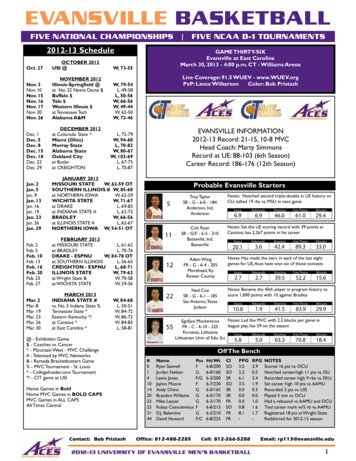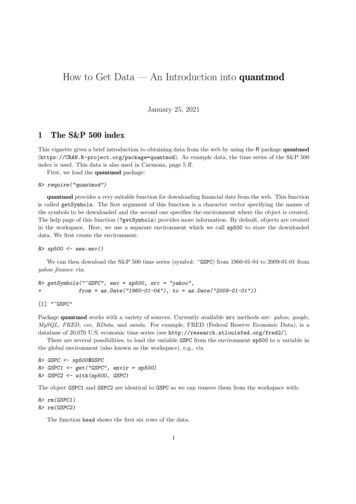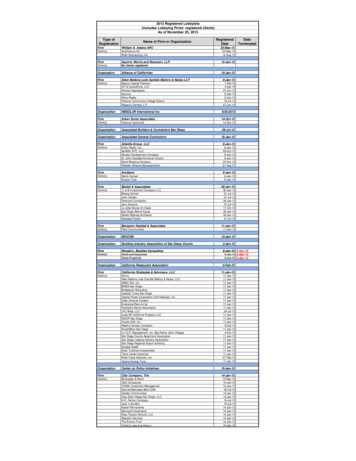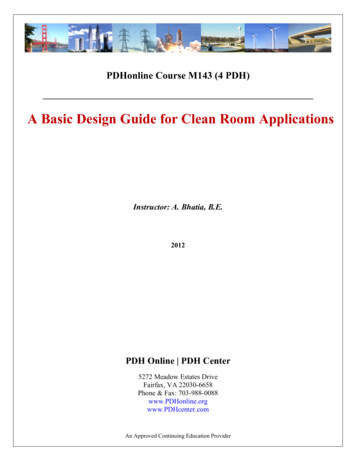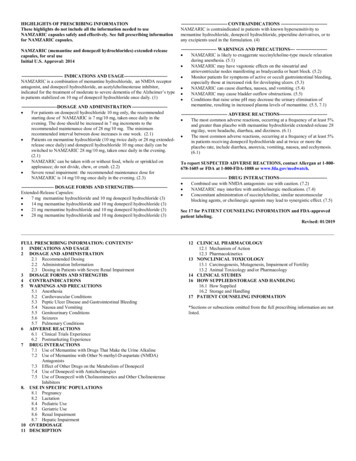
Transcription
HIGHLIGHTS OF PRESCRIBING INFORMATIONThese highlights do not include all the information needed to useNAMZARIC capsules safely and effectively. See full prescribing informationfor NAMZARIC capsules.------------------------------ CONTRAINDICATIONS -----------------------------NAMZARIC is contraindicated in patients with known hypersensitivity tomemantine hydrochloride, donepezil hydrochloride, piperidine derivatives, or toany excipients used in the formulation. (4)NAMZARIC (memantine and donepezil hydrochlorides) extended-releasecapsules, for oral useInitial U.S. Approval: 2014----------------------- WARNINGS AND PRECAUTIONS--- ------------------- NAMZARIC is likely to exaggerate succinylcholine-type muscle relaxationduring anesthesia. (5.1) NAMZARIC may have vagotonic effects on the sinoatrial andatrioventricular nodes manifesting as bradycardia or heart block. (5.2) Monitor patients for symptoms of active or occult gastrointestinal bleeding,especially those at increased risk for developing ulcers. (5.3) NAMZARIC can cause diarrhea, nausea, and vomiting. (5.4) NAMZARIC may cause bladder outflow obstructions. (5.5) Conditions that raise urine pH may decrease the urinary elimination ofmemantine, resulting in increased plasma levels of memantine. (5.5, 7.1)--------------------------- INDICATIONS AND USAGE ---------------------------NAMZARIC is a combination of memantine hydrochloride, an NMDA receptorantagonist, and donepezil hydrochloride, an acetylcholinesterase inhibitor,indicated for the treatment of moderate to severe dementia of the Alzheimer’s typein patients stabilized on 10 mg of donepezil hydrochloride once daily. (1)----------------------- DOSAGE AND ADMINISTRATION ---------------------- For patients on donepezil hydrochloride 10 mg only, the recommendedstarting dose of NAMZARIC is 7 mg/10 mg, taken once daily in theevening. The dose should be increased in 7 mg increments to therecommended maintenance dose of 28 mg/10 mg. The minimumrecommended interval between dose increases is one week. (2.1) Patients on memantine hydrochloride (10 mg twice daily or 28 mg extendedrelease once daily) and donepezil hydrochloride 10 mg once daily can beswitched to NAMZARIC 28 mg/10 mg, taken once daily in the evening.(2.1) NAMZARIC can be taken with or without food, whole or sprinkled onapplesauce; do not divide, chew, or crush. (2.2) Severe renal impairment: the recommended maintenance dose forNAMZARIC is 14 mg/10 mg once daily in the evening. (2.3)--------------------- DOSAGE FORMS AND STRENGTHS ---------------------Extended-Release Capsules: 7 mg memantine hydrochloride and 10 mg donepezil hydrochloride (3) 14 mg memantine hydrochloride and 10 mg donepezil hydrochloride (3) 21 mg memantine hydrochloride and 10 mg donepezil hydrochloride (3) 28 mg memantine hydrochloride and 10 mg donepezil hydrochloride (3)------------------------------ ADVERSE REACTIONS------------------------------ The most common adverse reactions, occurring at a frequency of at least 5%and greater than placebo with memantine hydrochloride extended-release 28mg/day, were headache, diarrhea, and dizziness. (6.1) The most common adverse reactions, occurring at a frequency of at least 5%in patients receiving donepezil hydrochloride and at twice or more theplacebo rate, include diarrhea, anorexia, vomiting, nausea, and ecchymosis.(6.1)To report SUSPECTED ADVERSE REACTIONS, contact Allergan at 1-800678-1605 or FDA at 1-800-FDA-1088 or - DRUG INTERACTIONS ------------------------------ Combined use with NMDA antagonists: use with caution. (7.2) NAMZARIC may interfere with anticholinergic medications. (7.4) Concomitant administration of succinylcholine, similar neuromuscularblocking agents, or cholinergic agonists may lead to synergistic effect. (7.5)See 17 for PATIENT COUNSELING INFORMATION and FDA-approvedpatient labeling.Revised: 01/2019FULL PRESCRIBING INFORMATION: CONTENTS*1 INDICATIONS AND USAGE2 DOSAGE AND ADMINISTRATION2.1 Recommended Dosing2.2 Administration Information2.3 Dosing in Patients with Severe Renal Impairment3 DOSAGE FORMS AND STRENGTHS4 CONTRAINDICATIONS5 WARNINGS AND PRECAUTIONS5.1 Anesthesia5.2 Cardiovascular Conditions5.3 Peptic Ulcer Disease and Gastrointestinal Bleeding5.4 Nausea and Vomiting5.5 Genitourinary Conditions5.6 Seizures5.7 Pulmonary Conditions6 ADVERSE REACTIONS6.1 Clinical Trials Experience6.2 Postmarketing Experience7 DRUG INTERACTIONS7.1 Use of Memantine with Drugs That Make the Urine Alkaline7.2 Use of Memantine with Other N-methyl-D-aspartate (NMDA)Antagonists7.3 Effect of Other Drugs on the Metabolism of Donepezil7.4 Use of Donepezil with Anticholinergics7.5 Use of Donepezil with Cholinomimetics and Other CholinesteraseInhibitors8. USE IN SPECIFIC POPULATIONS8.1 Pregnancy8.2 Lactation8.4 Pediatric Use8.5 Geriatric Use8.6 Renal Impairment8.7 Hepatic Impairment10 OVERDOSAGE11 DESCRIPTION12 CLINICAL PHARMACOLOGY12.1 Mechanism of Action12.3 Pharmacokinetics13 NONCLINICAL TOXICOLOGY13.1 Carcinogenesis, Mutagenesis, Impairment of Fertility13.2 Animal Toxicology and/or Pharmacology14 CLINICAL STUDIES16 HOW SUPPLIED/STORAGE AND HANDLING16.1 How Supplied16.2 Storage and Handling17 PATIENT COUNSELING INFORMATION*Sections or subsections omitted from the full prescribing information are notlisted.
FULL PRESCRIBING INFORMATION1INDICATIONS AND USAGENAMZARIC is indicated for the treatment of moderate to severe dementia of the Alzheimer’stype in patients stabilized on 10 mg of donepezil hydrochloride once daily.2DOSAGE AND ADMINISTRATION2.1Recommended DosingThe recommended dose of NAMZARIC is 28 mg/10 mg once daily.For patients stabilized on donepezil and not currently on memantine:For patients stabilized on donepezil hydrochloride 10 mg and not currently on memantinehydrochloride, the recommended starting dose of NAMZARIC is 7 mg/10 mg, taken once a dayin the evening. The dose should be increased in 7 mg increments of the memantine hydrochloridecomponent to the recommended maintenance dose of 28 mg/10 mg once daily. The minimumrecommended interval between dose increases is one week. The dose should only be increased ifthe previous dose has been well tolerated. The maximum dose is 28 mg/10 mg once daily.For patients stabilized on both donepezil and memantine:Patients stabilized on memantine hydrochloride (10 mg twice daily or 28 mg extended-releaseonce daily) and donepezil hydrochloride 10 mg once daily can be switched to NAMZARIC 28mg/10 mg, taken once a day in the evening. Patients should start NAMZARIC the day followingthe last dose of memantine hydrochloride and donepezil hydrochloride administered separately.If a patient misses a single dose of NAMZARIC, the next dose should be taken as scheduled,without doubling up the dose.2.2Administration InformationNAMZARIC can be taken with or without food. NAMZARIC capsules can be taken intact ormay be opened, sprinkled on applesauce, and swallowed without chewing. The entire contents ofeach NAMZARIC capsule should be consumed; the dose should not be divided.Except when opened and sprinkled on applesauce, as described above, NAMZARIC capsulesshould be swallowed whole. NAMZARIC capsules should not be divided, chewed, or crushed.2.3Dosing in Patients with Severe Renal ImpairmentFor patients stabilized on donepezil and not currently on memantine:For patients with severe renal impairment (creatinine clearance 5-29 mL/min, based on theCockcroft-Gault equation) stabilized on donepezil hydrochloride 10 mg once daily and notcurrently on memantine hydrochloride, the recommended starting dose of NAMZARIC is 7
mg/10 mg taken once a day in the evening. The dose should be increased to the recommendedmaintenance dose of 14 mg/10 mg once daily in the evening after a minimum of one week [seeUse in Specific Populations (8.6)].For patients stabilized on both donepezil and memantine:Patients with severe renal impairment, stabilized on memantine hydrochloride (5 mg twice dailyor 14 mg extended-release once daily) and donepezil hydrochloride 10 mg once daily, can beswitched to NAMZARIC 14 mg/10 mg, taken once daily in the evening.3DOSAGE FORMS AND STRENGTHSExtended-Release Capsules:4 7 mg memantine hydrochloride and 10 mg donepezil hydrochloride: light green opaquebody and an orange opaque cap with a black “FL 7/10” radial imprint 14 mg memantine hydrochloride and 10 mg donepezil hydrochloride: light green opaquecapsules with a black “FL 14/10” radial imprint 21 mg memantine hydrochloride and 10 mg donepezil hydrochloride: white opaque bodyand an orange opaque cap with a black “FL 21/10” radial imprint 28 mg memantine hydrochloride and 10 mg donepezil hydrochloride: blue opaquecapsules with a black “FL 28/10” radial imprintCONTRAINDICATIONSNAMZARIC is contraindicated in patients with known hypersensitivity to memantinehydrochloride, donepezil hydrochloride, piperidine derivatives, or to any excipients used in theformulation.5WARNINGS AND PRECAUTIONS5.1AnesthesiaDonepezil hydrochloride, an active ingredient in NAMZARIC, as a cholinesterase inhibitor, islikely to exaggerate succinylcholine-type muscle relaxation during anesthesia.5.2Cardiovascular ConditionsBecause of their pharmacological action, cholinesterase inhibitors may have vagotonic effects onthe sinoatrial and atrioventricular nodes. This effect may manifest as bradycardia or heart blockin patients both with and without known underlying cardiac conduction abnormalities. Syncopalepisodes have been reported in association with the use of donepezil hydrochloride, an activeingredient in NAMZARIC.
5.3Peptic Ulcer Disease and Gastrointestinal BleedingThrough their primary action, cholinesterase inhibitors may be expected to increase gastric acidsecretion due to increased cholinergic activity. Clinical studies of donepezil hydrochloride in adose of 5 mg/day to 10 mg/day have shown no increase, relative to placebo, in the incidence ofeither peptic ulcer disease or gastrointestinal bleeding. Patients treated with NAMZARIC shouldbe monitored closely for symptoms of active or occult gastrointestinal bleeding, especially thoseat increased risk for developing ulcers, e.g., those with a history of ulcer disease or thosereceiving concurrent nonsteroidal anti-inflammatory drugs (NSAIDs).5.4Nausea and VomitingDonepezil hydrochloride, an active ingredient in NAMZARIC, when initiated, as a predictableconsequence of its pharmacological properties, has been shown to produce diarrhea, nausea, andvomiting. Although in most cases, these effects have been mild and transient, sometimes lastingone to three weeks, and have resolved during continued use of donepezil hydrochloride, patientsshould be observed closely at the initiation of treatment.5.5Genitourinary ConditionsAlthough not observed in clinical trials of donepezil hydrochloride, an active ingredient inNAMZARIC, cholinomimetics may cause bladder outflow obstruction.Conditions that raise urine pH may decrease the urinary elimination of memantine, an activeingredient in NAMZARIC, resulting in increased plasma levels of memantine [see DrugInteractions (7.1)].5.6SeizuresCholinomimetics, including donepezil hydrochloride, an active ingredient in NAMZARIC, arebelieved to have some potential to cause generalized convulsions. However, seizure activity alsomay be a manifestation of Alzheimer’s disease.5.7Pulmonary ConditionsBecause of their cholinomimetic actions, cholinesterase inhibitors should be prescribed with careto patients with a history of asthma or obstructive pulmonary disease.6ADVERSE REACTIONSThe following serious adverse reactions are discussed below and elsewhere in the labeling. Cardiovascular Conditions [see Warnings and Precautions (5.2)]Peptic Ulcer Disease and Gastrointestinal Bleeding [see Warnings and Precautions (5.3)]Nausea and Vomiting [see Warnings and Precautions (5.4)]Genitourinary Conditions [see Warnings and Precautions (5.5)]Seizures [see Warnings and Precautions (5.6)]
6.1Pulmonary Conditions [see Warnings and Precautions (5.7)]Clinical Trials ExperienceBecause clinical trials are conducted under widely varying conditions, adverse reaction ratesobserved in the clinical trials of a drug cannot be directly compared to rates in the clinical trialsof another drug and may not reflect the rates observed in practice.Memantine HydrochlorideMemantine hydrochloride extended-release was evaluated in a double-blind, placebo-controlledtrial in 676 patients with moderate to severe dementia of the Alzheimer’s type (341 patientstreated with memantine 28 mg/day dose and 335 patients treated with placebo) for a treatmentperiod up to 24 weeks. Of the patients randomized, 236 treated with memantine 28 mg/day and227 treated with placebo were on a stable dose of donepezil for 3 months prior to screening.Adverse Reactions Leading to Discontinuation with Memantine HydrochlorideIn the placebo-controlled clinical trial of memantine hydrochloride extended-release, theproportion of patients in the memantine hydrochloride extended-release 28 mg/day dose groupand in the placebo group who discontinued treatment due to adverse reactions was 10% and 6%,respectively. The most common adverse reaction in the memantine hydrochloride extendedrelease treated group that led to treatment discontinuation was dizziness, at a rate of 1.5%.Most Common Adverse Reactions with Memantine HydrochlorideThe most common adverse reactions with memantine hydrochloride extended-release in patientswith moderate to severe Alzheimer’s disease, defined as those occurring at a frequency of at least5% in the memantine hydrochloride extended-release group and at a higher frequency thanplacebo, were headache, diarrhea, and dizziness.Table 1 lists adverse reactions that occurred at an incidence of 2% in the memantinehydrochloride extended-release treated group and occurred at a rate greater than placebo.
Table 1: Adverse reactions with memantine hydrochloride extended-release in patientswith moderate to severe Alzheimer’s diseasePlacebo(n 335)%Memantine hydrochlorideextended-release28 mg(n 341)%Diarrhea45Constipation13Abdominal on24Hypotension12Adverse ReactionGastrointestinal DisordersInfections and InfestationsInfluenzaInvestigationsIncreased weightMusculoskeletal and Connective Tissue DisordersBack painNervous System DisordersPsychiatric DisordersRenal and Urinary DisordersUrinary incontinenceVascular Disorders
Donepezil hydrochlorideAdverse Reactions Leading to Discontinuation with Donepezil HydrochlorideIn controlled clinical trials of donepezil hydrochloride, the rate of discontinuation due to adversereactions for patients treated with donepezil hydrochloride was approximately 12%, compared to7% for patients treated with placebo. The most common adverse reactions leading todiscontinuation, defined as those occurring in at least 2% of donepezil hydrochloride patients andat twice or more the incidence seen with placebo, were anorexia (2%), nausea (2%), diarrhea(2%) and urinary tract infection (2%).Most Common Adverse Reactions with Donepezil HydrochlorideThe most common adverse reactions reported with donepezil hydrochloride in controlled clinicaltrials in patients with severe Alzheimer’s disease, defined as those occurring at a frequency of atleast 5% in the donepezil hydrochloride group and at twice or more the placebo rate, werediarrhea, anorexia, vomiting, nausea, and ecchymosis. The most common adverse reactionsreported with donepezil hydrochloride in controlled clinical trials in patients with mild tomoderate Alzheimer’s disease were insomnia, muscle cramp, and fatigue.Table 2 lists adverse reactions that occurred at an incidence of 2% in the donepezilhydrochloride group and at a rate greater than placebo in controlled trials in patients with severeAlzheimer’s disease.Table 2: Adverse reactions with donepezil hydrochloride in patients with severeAlzheimer’s disease73Donepezil hydrochloride10 mg/day(n k pain23Body System/Adverse EventPercent of Patients with any Adverse EventPlacebo(n 392)%Body as a Whole
Table 2: Adverse reactions with donepezil hydrochloride in patients with severeAlzheimer’s diseaseFever12 miting48Anorexia48Nausea2625Increased creatine phosphokinase13Dehydration12Hyperlipemia 13Somnolence12Chest painCardiovascular SystemDigestive SystemHemic and Lymphatic SystemEcchymosisMetabolic and Nutritional SystemsNervous System
Table 2: Adverse reactions with donepezil hydrochloride in patients with severeAlzheimer’s diseaseDizziness12Depression12Confusion12Emotional lability12Personality disorder122312Skin and AppendagesEczemaUrogenital SystemUrinary incontinence6.2Postmarketing ExperienceThe following adverse reactions have been identified during post-approval use of memantinehydrochloride and donepezil hydrochloride. Because these reactions are reported voluntarilyfrom a population of uncertain size, it is not always possible to reliably estimate their frequencyor establish a causal relationship to drug exposure.Memantine HydrochlorideAcute renal failure, agranulocytosis, cardiac failure congestive, hepatitis, leukopenia (includingneutropenia), pancreatitis, pancytopenia, Stevens-Johnson syndrome, suicidal ideation,thrombocytopenia, and thrombotic thrombocytopenic purpura.Donepezil HydrochlorideAbdominal pain, agitation, cholecystitis, confusion, convulsions, hallucinations, heart block (alltypes), hemolytic anemia, hepatitis, hyponatremia, neuroleptic malignant syndrome, pancreatitis,and rash.7DRUG INTERACTIONS7.1Use of Memantine with Drugs That Make the Urine AlkalineThe clearance of memantine was reduced by about 80% under alkaline urine conditions at pH 8.Therefore, alterations of urine pH towards the alkaline condition may lead to an accumulation of
the drug with a possible increase in adverse reactions. Urine pH is altered by diet, drugs(e.g., carbonic anhydrase inhibitors, sodium bicarbonate) and clinical state of the patient(e.g., renal tubular acidosis or severe infections of the urinary tract). Hence, memantine shouldbe used with caution under these conditions.7.2Use of Memantine with Other N-methyl-D-aspartate (NMDA) AntagonistsThe combined use of memantine hydrochloride with other NMDA antagonists (amantadine,ketamine, and dextromethorphan) has not been systematically evaluated and such use should beapproached with caution.7.3Effect of Other Drugs on the Metabolism of DonepezilInhibitors of CYP3A4 (e.g., ketoconazole) and CYP2D6 (e.g., quinidine), inhibit donepezilmetabolism in vitro. Whether there is a clinical effect of quinidine is not known.Inducers of CYP3A4 (e.g., phenytoin, carbamazepine, dexamethasone, rifampin, andphenobarbital) could increase the rate of elimination of donepezil.7.4Use of Donepezil with AnticholinergicsBecause of their mechanism of action, cholinesterase inhibitors, including donepezilhydrochloride, have the potential to interfere with the activity of anticholinergic medications.7.5Use of Donepezil with Cholinomimetics and Other Cholinesterase InhibitorsA synergistic effect may be expected when cholinesterase inhibitors, including donepezilhydrochloride, are given concurrently with succinylcholine, similar neuromuscular blockingagents, or cholinergic agonists such as bethanechol.8.USE IN SPECIFIC POPULATIONS8.1PregnancyRisk SummaryThere are no adequate data on the developmental risk associated with the use of NAMZARIC orits active ingredients (memantine hydrochloride and donepezil hydrochloride) in pregnantwomen.Adverse developmental effects (mortality and decreased body weight and skeletal ossification)were observed in the offspring of rats administered memantine or donepezil during pregnancy atdoses associated with minimal maternal toxicity. These doses are higher than those used inhumans at the recommended daily dose of NAMZARIC [see Data].
In the U.S. general population, the estimated background risk of major birth defects and miscarriagein clinically recognized pregnancies is 2-4% and 15-20%, respectively. The background risk ofmajor birth defects and miscarriage for the indicated population is unknown.DataAnimal DataMemantine HydrochlorideOral administration of memantine (2, 6, or 18 mg/kg/day) to rats during the period oforganogenesis resulted in decreased skeletal ossification in fetuses at the highest dose tested. Thehigher no-effect dose for adverse developmental effects (6 mg/kg) is 2 times the dose ofmemantine at the recommended human daily dose (RHD) of NAMZARIC (28 mg memantine/10mg donepezil) on a body surface area (mg/m2) basis.Oral administration of memantine to rabbits (3, 10, or 30 mg/kg/day) during the period oforganogenesis resulted in no adverse developmental effects. The highest dose tested isapproximately 20 times the dose of memantine at the RHD of NAMZARIC on a mg/m2 basis.In rats, memantine (2, 6, or 18 mg/kg/day) was administered orally prior to and throughoutmating and, in females, through the period of organogenesis or continuing throughout lactationto weaning. Decreased skeletal ossification in fetuses and decreased body weight in pups wereobserved at the highest dose tested. The higher no-effect dose for adverse developmental effects(6 mg/kg/day) is 2 times the dose of memantine at the RHD of NAMZARIC on a mg/m2 basis.Oral administration of memantine (2, 6, or 18 mg/kg/day) to rats from late gestation throughoutlactation to weaning, resulted in decreased pup weights at the highest dose tested. The higher noeffect dose (6 mg/kg/day) is approximately 2 times the dose of memantine at the RHD ofNAMZARIC on a mg/m2 basis.Donepezil HydrochlorideOral administration of donepezil to rats and rabbits during the period of organogenesis resultedin no adverse developmental effects. The highest doses (16 and 10 mg/kg/day, respectively) wereapproximately 15 and 7 times, respectively, the dose of donepezil at the RHD of NAMZARIC ona mg/m2 basis.Oral administration of donepezil (1, 3, or 10 mg/kg/day) to rats during late gestation andthroughout lactation to weaning resulted in an increase in stillbirths and offspring mortality at thehighest dose tested. The higher no-effect dose (3 mg/kg/day) is approximately 3 times the doseof donepezil at the RHD of NAMZARIC on a mg/m2 basis.8.2LactationRisk Summary
There are no data on the presence of memantine or donepezil in human milk, the effects on thebreastfed infant, or the effects of NAMZARIC or its metabolites on milk production.The developmental and health benefits of breastfeeding should be considered along with themother’s clinical need for NAMZARIC and any potential adverse effects on the breastfed infantfrom NAMZARIC or from the underlying maternal condition.8.4Pediatric UseSafety and effectiveness of NAMZARIC in pediatric patients have not been established.Memantine failed to demonstrate efficacy in two 12-week controlled clinical studies of578 pediatric patients aged 6-12 years with autism spectrum disorders (ASD), including autism,Asperger’s disorder and Pervasive Development Disorder - Not Otherwise Specified (PDDNOS). Memantine has not been studied in pediatric patients under 6 years of age or over 12 yearsof age. Memantine treatment was initiated at 3 mg/day and the dose was escalated to the targetdose (weight-based) by week 6. Oral doses of memantine 3, 6, 9, or 15 mg extended-releasecapsules were administered once daily to patients with weights 20 kg, 20-39 kg, 40-59 kg and 60 kg, respectively.In a randomized, 12-week double-blind, placebo-controlled parallel study (Study A) in patientswith autism, there was no statistically significant difference in the Social Responsiveness Scale(SRS) total raw score between patients randomized to memantine (n 54) and those randomizedto placebo (n 53). In a 12-week responder-enriched randomized withdrawal study (Study B) in471 patients with ASD, there was no statistically significant difference in the loss of therapeuticresponse rates between patients randomized to remain on full-dose memantine (n 153) and thoserandomized to switch to placebo (n 158).The overall risk profile of memantine in pediatric patients was generally consistent with theknown risk profile in adults [see Adverse Reactions (6.1)].In Study A, the adverse reactions in the memantine group (n 56) that were reported in at least5% of patients and at least twice the frequency of the placebo group (N 58) are listed in Table 3:Table 3: Study A Commonly Reported Adverse Reactions With a Frequency 5% and Twice That of PlaceboAdverse ReactionMemantinePlaceboN 56N itation5.4%1.7%Discontinuations due to adverse reactionsaAggression3.6%1.7%Irritability1.8%3.4%
aReported adverse reactions leading to discontinuation in more than one patient ineither treatment group.The adverse reactions that were reported in at least 5% of patients in the 12-48 weekopen-label study to identify responders to enroll in Study B are listed in Table 4:Table 4: 12-48 Week Open Label Lead-In study to Study B CommonlyReported Adverse Reactions with a Frequency 5%Adverse ReactionMemantineN ability5.4%Discontinuations due to adverse reactionsaIrritability1.2%Aggression1.0%aAt least 1% incidence of adverse reactions leading to premature discontinuation.In the randomized withdrawal study (Study B), the adverse reaction in patients randomized toplacebo (n 160) and reported in at least 5% of patients and at twice the frequency of the fulldose memantine treatment group (n 157) was irritability (5.0% vs 2.5%).In a juvenile animal study, male and female juvenile rats were administered memantine(15, 30, and 45 mg/kg/day) starting on postnatal day (PND) 14 through PND 70. Body weightswere reduced at 45 mg/kg/day. Delays in sexual maturation were noted in male and female ratsat doses 30 mg/kg/day. Memantine induced neuronal lesions in several areas of the brain onPND 15 and 17 at doses 30 mg/kg/day. Behavioral toxicity (decrease percent of auditory startlehabituation) was noted for animals in the 45 mg/kg/day dose group. The 15 mg/kg/day dose wasconsidered the No-Observed-Adverse-Effect-Level (NOAEL) for this study.In a second juvenile rat toxicity study, male and female juvenile rats were administeredmemantine (1, 3, 8, 15, 30, and 45 mg/kg/day) starting on postnatal day (PND) 7 through PND70. Due to early memantine-related mortality, the 30 and 45 mg/kg/day dose groups wereterminated without further evaluation. Memantine induced apoptosis or neuronal degeneration inseveral areas of the brain on PND 8, 10, and 17 at a dose of 15 mg/kg/day. The NOAEL forapoptosis and neuronal degeneration was 8 mg/kg/day. Behavioral toxicity (effects on motoractivity, auditory startle habituation, and learning and memory) was noted at doses 3mg/kg/day during treatment, but was not seen after drug discontinuation. Therefore, the 1mg/kg/day dose was considered the NOAEL for the neurobehavioral effect in this study.8.5Geriatric UseMemantine Hydrochloride
The majority of people with Alzheimer’s disease are 65 years and older. In the clinical study ofmemantine hydrochloride extended-release, the mean age of patients was approximately 77years; over 91% of patients were 65 years of age and older, 67% were 75 years of age and older,and 14% were 85 years of age and older. The efficacy and safety data presented in the clinicaltrials section were obtained from these patients. There were no clinically meaningful differencesin most adverse events reported by patients 65 years old and 65 years old.Donepezil HydrochlorideThe mean age of patients enrolled in the clinical studies with donepezil hydrochloride was73 years; 80% of these patients were between 65 and 84 years of age, and 49% of patients 75years of age and older. The efficacy and safety data presented in the clinical trials section wereobtained from these patients. There were no clinically significant differences in most adverseevents reported by patients 65 years old and 65 years old.8.6Renal ImpairmentA dosage reduction is recommended in patients with severe renal impairment [see Dosage andAdministration (2.3) and Clinical Pharmacology (12.3)]. No dosage adjustment is needed inpatients with mild or moderate renal impairment.8.7Hepatic ImpairmentNo dosage adjustment is needed in patients with mild or moderate hepatic impairment.NAMZARIC has not been studied in patients with severe hepatic impairment [see ClinicalPharmacology (12.3)].10OVERDOSAGEMemantine hydrochloride and donepezil hydrochloride are the two active ingredients ofNAMZARIC. No specific antidote for memantine hydrochloride overdose is known; however,elimination of memantine can be increased by acidification of the urine. Tertiary anticholinergicssuch as atropine may be used as an antidote for donepezil hydrochloride overdose. In managingcases of overdose, consider the possibility of multiple drug involvement. In case of overdose,call Poison Control Center at 1-800-222-1222 for the latest recommendation. In general,supportive measures should be utilized, and treatment should be symptomatic.Memantine HydrochlorideSigns and symptoms most often accompanying overdosage with other formulations of memantinein clinical trials and from worldwide marketing experience, alone or in combination with otherdrugs and/or alcohol, include agitation, asthenia, bradycardia, confusion, coma, dizziness, ECGchanges, increased blood pressure, lethargy, loss of consciousness, psychosis, restlessness,slowed movement, somnolence, stupor, unsteady gait, visual hallucinations, vertigo, vomiting,and weakness. The largest known ingestion of memantine worldwide was 2 grams in anindividual who took memantine in conjunction wi
21 mg memantine hydrochloride and 10 mg donepezil hydrochloride: white opaque body and an orange opaque cap with a black "FL 21/10" radial imprint 28 mg memantine hydrochloride and 10 mg donepezil hydrochloride: blue opaque capsules with a black "FL 28/10" radial imprint 4 CONTRAINDICATIONS
